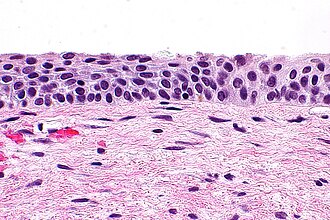Uterine cervix with atrophic changes
Jump to navigation
Jump to search
| Uterine cervix with atrophic changes | |
|---|---|
| Diagnosis in short | |
 Atrophic cervix. H&E stain. | |
|
| |
| LM | small squamous cells with grey/blue cytoplasm, no "dancing"/"sparkling" chromatin, no mitoses |
| LM DDx | HSIL |
| IHC | p16 -ve, Ki-67 rare basal cells |
| Site | uterine cervix - exocervix |
|
| |
| Clinical history | old |
| Prevalence | common |
| Prognosis | benign |
| Other | normal - postmenopausal |
Uterine cervix with atrophic changes is relatively common and is important to recognize as it can mimic HSIL.
It is also known as atrophy of the uterine cervix, cervical atrophy, atrophy of the cervix and cervix with atrophic changes.
General
- Common.
- Post-menupausal.
- Important to recognize and differentiate from HSIL.
Microscopic
Features:
- Cells smaller.
- Cytoplasm grey/blue.
- No "dancing"/"sparkling" chromatin.
- No mitoses.
DDx:
- HSIL.
Images
www:
- Atrophic cervix (nih.techriver.net).
- Atrophic cervix (flickriver.com/euthman).
- Atrophic changes in the vagina (eurocytology.eu).[1]
IHC
- p16 -ve.
- Ki-67 rare basal cells.
Sign out
UTERINE CERVIX, BIOPSY: - SQUAMOUS MUCOSA WITH ATROPHIC CHANGES. - BENIGN ENDOCERVICAL EPITHELIUM. - NEGATIVE FOR DYSPLASIA. COMMENT: A p16 immunostain is negative. A Ki-67 immunostain marks rare basal cells.
See also
References
- ↑ URL: http://www.eurocytology.eu/static/eurocytology/TUR/cervical/LP1ContentLcontC.html. Accessed on: 13 December 2013.






